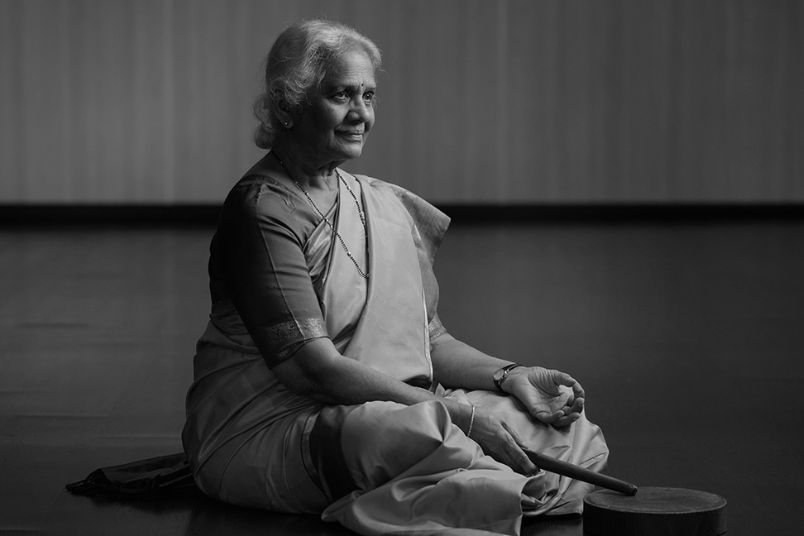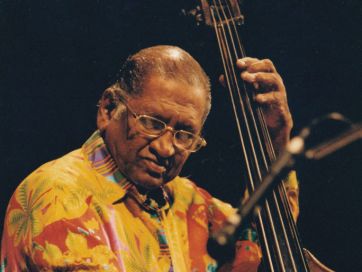Pankyamma Santhamma w/o K P Bhaskar, better known to us as Mrs Santha Bhaskar, passed away suddenly on Saturday, 26 February 2022. She was NUS’ longest-serving artistic tutor, nurturing generations of NUS students for well over 40 years. More than an artistic director, a mentor and teacher, Mrs Bhaskar embodied the very heart and soul of the arts, expressed through her dedication to her craft.
Originally hailing from Kerala, India, Mrs Bhaskar first arrived in Singapore in 1955, as the 16-year-old bride of the late K. P. Bhaskar, founder of Bhaskar’s Arts Academy. Together, they became pioneers and doyens of Indian Dance in Singapore. With a focus on Bharatanatyam, the Bhaskars dedicated themselves to teaching Indian Dance to generations of dancers in Singapore, a passionate pursuit that became their life’s work. One of their former students fondly recalls being under the Bhaskars’ tutelage:
“When Mrs Bhaskar came to Singapore in 1955, I was 13 years old and already a student of Mr Bhaskar. I took over my sister’s spot when she decided not to continue with her dance lessons. They held classes at my home in New Bridge Road. The Bhaskars made a lovely couple. In the years after, we toured almost the whole of West Malaysia holding concerts. That time will be etched in my memory forever.” – Navena Rajaratnam, teacher
Indian Dance in NUS
It was in 1977 that Mrs Bhaskar began her journey with NUS as an instructor for Indian Dance. Invited by then-head of musical activities, the late Paul Abishegenaden, Mrs Bhaskar began teaching Indian Dance – first holding classes in makeshift studios and spaces on campus, before eventually moving into a purpose-built dance studio. She recalls the moment that Abishegenaden welcomed her into the new studio space, saying, “Santha, this studio is yours. Enjoy teaching.”

In the decades since, Mrs Bhaskar built a solid repertoire for NUS Indian Dance, with over 100 pieces performed on and off campus. Particularly evident in her work is a love for collaborations across cultures and artistic disciplines, while firmly rooted in the traditions of classical Indian movement and costume. She fearlessly embraced new themes and forms, adapting Chinese epics, Shakespearean plays and local poetry, often incorporating drama, multimedia, and visual arts in a heady melange of sight and sound. It was her firm conviction that this multi-disciplinary approach enhanced the appeal of its constituent art forms, helping newer audiences gain a fresh appreciation for traditional arts.
“Mrs Bhaskar grounded our students in the fundamentals of Bharatanatyam, yet was always up to the challenge of examining current issues and working with new disciplines and new areas of knowledge. She set an example as one who was always curious, always learning, and always growing.” – Sharon Tan, Director for NUS Centre For the Arts

This was most apparent in her collaborations with various academic departments, such as the Centre For Quantum Technologies (CQT) with Sambhavna (2016) and Sambhavna 2.0 (2017). Jenny Hogan from CQT recalls being told that Mrs Bhaskar was first to step up to the challenge of tackling the challenging theme of quantum physics for NUS Arts Festival 2016.
“Mrs Bhaskar was brave and joyful in taking on this new topic, so different to her training in Bharatanatyam. We had the privilege of appointing Mrs Bhaskar an honorary Outreach Fellow at the Centre for Quantum Technologies for the collaboration, hosting her for meetings with researchers and to visit experimental labs. That year, she choreographed for NUS Indian Dance a short work called Sambhavna, meaning probability, that was inspired by the wave-particle behaviour of quantum-scale particles. This was developed into a full production for the 2017 festival.
We were lucky to work together again during The Golden Record series of theatre pieces, one outcome of which was the CQT satellite SpooQy-1 carrying a quote from Mrs Bhaskar into orbit. From June 2019 to October 2021, her words “We are all different nationals, we are entangled together with all the races” circled the Earth.
Her keen curiosity about the world and enthusiasm to be adventurous in her work were deeply inspiring.” – Jenny Hogan, Centre for Quantum Technologies
Her intellectual curiousity extended beyond cutting-edge science, collaborating with the Department of Geography in Maya Yatra (2018), and the Department of Mathematics, Faculty of Science in 28 (2019). She immersed herself in these academic disciplines, even taking crash courses from family and faculty in order to assimilate and meld these theoretical frameworks, developing innovative artistic expressions that shed new light on these concepts.
“Mrs Bhaskar was a cultural icon who never shied away from experimental work. She was critical, curious, and always willing to include academics and students in her creative process. I benefited greatly from her interdisciplinary approach and willingness to engage with Geography, gender and the body for Maya Yatra in 2018.” – Dr Kamalini Ramdas, Senior Lecturer in the Department of Geography.

She broke new ground by pioneering exploration of intercultural multi-disciplinary work such as Vriksha which presented Kuo Pao Kun’s The Silly Little Girl and The Old Tree in Bharatanatyam and working with local poets such as Emeritus Professor Edwin Thumboo, Alvin Pang, Mohd Ghani Hamid, to present their poetic works through dance. She also appeared as herself in The Golden Record 3.0 (2019), a play directed by Edith Podesta as part of the Singapore Bicentennial Celebrations by NUS Centre For the Arts.
“Over the years, it has been an honour and pleasure for NUS Electronic Music Lab to collaborate with the late Mrs Santha Bhaskar, not only a brilliant and highly respected artist, but also a very nice person. We will miss her greatly.” – Benjamin Ang, Principal Tutor, Electronic Music Lab
For her contributions to the arts in Singapore, Mrs Bhaskar was awarded Singapore’s highest arts accolade, the Cultural Medallion for Dance, in 1990. She was also conferred the Public Service Star (Bintang Bakti Masyarakat) in 2016 and the Meritorious Service Medal (Pingat Jasa Gemilang) in 2021. She was also inducted into the Singapore Women’s Hall of Fame, Arts and Culture in 2021.
A Personal Legacy

Beyond the achievements and accolades, Mrs Bhaskar’s true legacy is in the many generations of students and dancers who have been privileged to work with her. Affectionately known to them as “Aunty”, Mrs Bhaskar’s love for dance was matched only by her sense of humour and joie de vivre.
“I will always remember aunty as a cute little grandma that never fails to make us laugh. She has on many occasions surprised us by singing cinema songs or going along with our antics in class. I’m going to miss her giggles and laughing with her at rehearsals.” – Priyadarshini Nagarajah, FASS 2017, former NUS Indian Dance member
She instilled in her students a deep love and respect for Bharatanatyam and the arts, grounding them in the fundamentals of the traditional art form, while challenging them to relate their art to the issues of the day, and expand the reach of Indian Dance through multi-disciplinary collaborations. It was in this passing of traditions, skills, and mindsets that Mrs Bhaskar found the most satisfaction, especially when her former students became choreographers, or placed their children under her tutelage.

While she was lauded for her trailblazing work, Mrs Bhaskar’s passion for her art remained surprisingly humble and pure.
“As artists, we learn to not expect everybody to appreciate what we do,” said Mrs Bhaskar. “We continue doing it because it’s a part of us, and we naturally want to pass it on.”
Share:
Contributor
Office of Student Affairs



